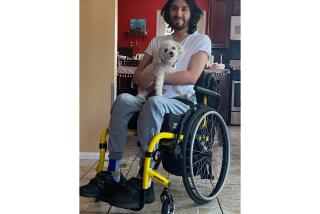Shooting Raises Questions
- Share via
Last weekend’s tragic shoot-out between SWAT officers and Robert Gary Taschner, in which both Taschner and Deputy Lonny G. Brewer were killed, has left many questions.
Why did officers take offensive action so quickly? Taschner had no hostages and neighbors had been evacuated. Couldn’t they have tried to outwait him, perhaps shutting off electricity and water to the apartment? How did Taschner get his AK-47 assault rifle? Only a few days earlier, Escondido police thought they had confiscated all of his weapons.
Also unexplained is why a deputy shot at Taschner from point-blank range after he was on the ground. Thus far, we have only the Sheriff’s Department’s assurance that there was a good reason.
As the investigations continue, there may be a broader question as well: Is there a better way to identify and monitor mentally ill people who are inclined to violence?
Taschner had three encounters with law enforcement officers in the previous seven weeks--two of them arrests on gun and drug charges. Numerous weapons were confiscated from him in those two encounters, including another AK-47 rifle.
The third encounter was on Dec. 4 as the result of a telephone call from an Escondido high school teacher who said Taschner appeared at her door at 5 a.m. “raving about talking to the angels . . . and that he was on a quest for love.” She said Taschner told her that he had just gotten out of jail. He had.
A deputy stopped Taschner on Jesmond Dene Road a short time after the teacher’s call, but he said he released Taschner because he had committed no crime and did not appear to be a danger to himself or others. A little more than 24 hours later, Taschner shot up his apartment, then opened fire on police.
The deputy on Jesmond Dene Road did not have a crystal ball, and his decision is one any of us might have made.
But perhaps there is more that could be done with the resources at hand.
For example, the county has a computer system, known as ARJIS, which contains information on arrests made throughout the county. ARJIS’ primary use in its eight-year history has been as an investigative tool, but patrol officers do have access to the computer and increasingly are using it when they write their reports after an arrest.
Using the computer system from the field is more cumbersome. But information about previous arrests can be critical to an officer’s safety and might help them with their often-difficult decisions. Perhaps ARJIS should become a routine tool for patrol officers.
Perhaps officers need additional training in spotting mentally ill people.
Or maybe there is a way for police officers to have access to a psychiatrist--much the way paramedics discuss symptoms with a physician--when they are trying to decide whether a person’s behavior warrants hospitalization.
Further decentralization of the county mental health system so that North County officers needn’t drive to the county mental hospital in Hillcrest might also make evaluation simpler.
Perhaps there just isn’t any more we can do than we do now. But one thing is clear; tragic events like the Taschner case occur all too frequently. Anything that reasonably can be done to better equip police officers to spot the Robert Gary Taschners among us and allow our justice and mental health systems to work to their fullest should be tried.
More to Read
Sign up for Essential California
The most important California stories and recommendations in your inbox every morning.
You may occasionally receive promotional content from the Los Angeles Times.













